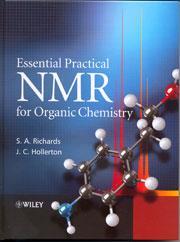Essential practical NMR for organic chemistry
Essential practical NMR for organic chemistry
S A Richards and J C Hollerton
Chichester, UK: John Wiley 2011 | 228 pp | ?45.00 (HB)
ISBN 9780470710920
Reviewed by Tim Claridge

This book seeks to provide the organic chemist with a practical guide to the most common nuclear magnetic resonance (NMR) methods used for small molecule structure confirmation and is a follow-up text to the 1988 Laboratory guide to proton NMR spectroscopy produced by the first author.
It contains advice on sample preparation, experiment selection and data interpretation, highlighting some of the common mistakes or misconceptions the authors have witnessed over their combined 60 years in pharmaceutical NMR.
It is aimed primarily at synthetic chemists employing automated ’walk-up’ spectrometers and as such focuses on the application of the most common 1H and 13C techniques, whilst avoiding technical details or underlying theory. Later chapters cover topics such as liquid chromatography (LC)-NMR, other nuclei (19F, 31P, 15N), quantification, safety and software, albeit very briefly, finishing with 10 problems with comprehensive answers.
Descriptions are clearly presented although, unfortunately, the authors chose to retain use of inappropriate terminology describing resonance positions as being upfield or downfield, despite acknowledging that this is technically correct only for continuous wave NMR and not for the now ubiquitous Fourier transform approach, a point commonly misunderstood. In the text this leads to confusing descriptions such as a proton peak at 7.2 ppm being below 7 ppm, and a negative proton shift as being above tetramethylsilane (TMS).
The style is informal and the content pragmatic with minimal technical detail, making for easy reading. It differs from many other books in trying to explain how organic structures can be confirmed with routine NMR methods without distraction from underlying theory.
While not an introductory NMR text (it lacks information describing the physical mechanisms influencing chemical shifts or spin-coupling, for example), practising organic chemists should find this a useful source of guidance, tips and even tricks to help them make the most of the NMR facilities at their disposal, whether in academia or industry.












No comments yet